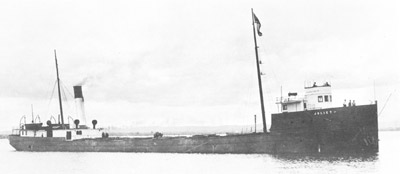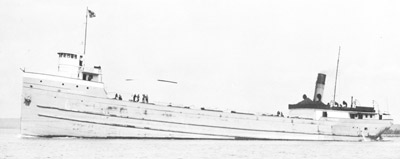Table of Contents
In the year 1853, the mining of iron ore was in its infancy, only a few years having passed since the Houghton expeditions to Lake Superior in the 1840's, explorations which led to a realization of the richness of the great mineral deposits in the Lake Superior area. 1853 saw the founding of the Lake Superior Iron Company, an enterprise of the three Ely brothers of Marquette, Michigan - Herman, George and Samuel. The purpose of the firm was to mine and market ore from the Marquette Range of Michigan's Upper Peninsula. It is interesting to note that, at a later date, James J. Hill, "the Railroad Builder," appears to have become a major shareholder.
At the end of the next last decade of the nineteenth century, the Lake Superior Iron Company ordered four bulk carriers from the Cleveland Shipbuilding Company. Delivered in 1890 and 1891, they were GRIFFIN (U. S. 86140), JOLIET (U. S. 76873), LA SALLE (U. S. 141050) and WAWATAM (U. S. 81324). Generally similar in appearance, the ships divided off into two pairs of sisterships as far as dimensions were concerned. GRIFFIN and WAWATAM measured 266.0 feet in length, 38.2 feet in beam, and 19.6 feet in depth, and both showed tonnage of 1856 Gross, 1526 Net. JOLIET and LA SALLE measured 266.0 x 38. 0 x 19.9 and each of these had tonnage shown as 1921 Gross, 1596 Net. Only two of the Hull numbers are known to your writer, LA SALLE being Hull 6 and GRIFFIN being Hull 12. All four steamers were fitted with the same machinery, triple expansion engines with cylinders of 17", 29" and 47" and a stroke of 36".
The Lake Superior Iron Company operated the four steamers until November 1898 when they were sold to Andrew Carnegie's Pittsburgh Steamship Company (no relation to the later fleet of the same name which will be mentioned further on in this history). Carnegie had found out that his rival, John D. Rockefeller (the Bessemer Steamship Company), was not disposed to carry Carnegie ore in his vessels and accordingly Henry W. Oliver, as Carnegie's agent, was attempting to put together a fleet of steamers to transport the Carnegie ore to the blast furnaces of the Lake Erie region. As a result of the sale, the quartet of vessels traded their L. S. I. Co. colours (black hull, white cabins, black stack with a white "S") for the livery of the Pittsburgh Steamship Company, namely, red hull, white cabins and black stack bearing a white "P" similar to the current Paterson funnel marking.
During these years, however, another giant was in the making. This was J. Pierpont Morgan's United States Steel Company which was formed largely as a result of the efforts of Morgan's financial "advisor", Elbert H. Gary. Together they managed to force Carnegie's hand and on February 25, 1901, Carnegie's vessels came under the ownership of United States Steel's subsidiary, the Pittsburgh Steamship Company. During the very early years, the vessels of this very large fleet were painted an olive green colour, with white houses and all-silver stacks. Very shortly, however, the funnels acquired a more practical black smoke band over the silver and the hull colour was changed to the familiar red still used by U. S. Steel vessels today.
Although they were small by standards set early in the new century, the four L. S. I. Co. steamers proved to be successful and three of the four saw long service. In fact, two of the ships saw service past their seventieth year. Their stories began to diverge in 1911 and from there we shall deal separately with each vessel.
This steamer remained in the Pittsburgh fleet until 1911 and was the first of the quartet to fall by the wayside. Perhaps an accident that befell her very early in her life was an omen of things to come. In August of 1890, she was forced ashore in the St. Mary's River by an errant log raft which filled the entire channel. JULIET sustained severe bottom damage from striking the rocky shore, but she was quickly repaired and put back in service.

This photo by A. E. Young shows JOLIET above the Soo Locks in 1911, her last year of service. She was soon to be lost by collision.
On September 22, 1911, JOLIET was anchored in the upper St. Clair River at Sarnia, waiting out one of the late summer fogs which so often descend on the area. In the dense fog she was run down and sunk by the big steamer HENRY PHIPPS, a unit of the same fleet, which had not anchored to await clearing weather. The eighteen crew members of JOLIET were picked up by the nearby steamer POLYNESIA (later the A. D. MacBETH) and no lives were lost. Meanwhile the PHIPPS, having dealt JOLIET a fatal blow continued on downstream and collided with the Wyandotte Chemicals self-unloader ALPENA which sustained minor damage.
Pittsburgh decided that JOLIET was not worth the cost of salvage and the company engaged the services of the Reid Wrecking Company of Sarnia and Port Huron to break up the wreck by means of dynamite. As the wreck was close by the St. Clair River railroad tunnel, reduced charges had to be used. In 1941 the U. S. Government located the wreck and close examination proved that the small explosive charges had only bulged the hull plating. New efforts were made and thereupon the hull of JOLIET was finally broken up.
In 1913 the Pittsburgh Steamship Company sold the three remaining vessels of our quartet. Ownership passed, through Thomas Morrison of Cleveland, to the Atlas Steamship Company of Duluth, R. C. Helm, manager. WAWATAM, however, did not linger long in this fleet for in 1914 she was purchased by James Playfair's Great Lakes Transportation Company Ltd. of Midland, Ontario. She was brought into Canadian registry (C. 134261) and was renamed (b) GLENLIVET.
GLENLIVET operated in the Canadian grain trade, bearing the Playfair gray hull and red and black funnel, until April 1926 when she and the other vessels in the G. L. T. Co. Ltd. wore absorbed by Canada Steamship Lines Ltd., Montreal. During the summer months she was given her final name, (c) SASKATCHEWAN, but she did not operate long with this new name. The takeover of the Playfair fleet had given C. S. L. a number of smaller and older carriers which were surplus to the company's requirements and SASKATCHEWAN was one of these. She did not operate after the 1928 season and, along with PORTSMOUTH (GLENSANNOX), HUGUENOT (GLENRIG) and SARNIAN, she lay idle alongside the shipyard at Midland. In 1937 she was finally sold for scrapping and was dismantled right at the shipyard where she lay.

WAWATAM is seen in her later years, serving the Playfair fleet as GLENLIVET. Young photo dated 1924.
We know of only one major accident in WAWATAM's life. On September 7, 1901, with the whaleback barge 202 in tow, she was caught in heavy weather and stranded on Gratiot Beach above Port Huron. She does not appear to have suffered serious damage. Two other vessels went aground but a stone throw away from where WAWATAM and her tow were in trouble, these being the wooden steamer JOHN H. PAULY and her tow, the barge AMARANTH.
Along with her mates, this steamer changed her colours in 1913 for those of the Atlas Steamship Company. She stayed with Atlas the longest of any of the three ships for it was not until 1928 that she was purchased by the Eastern Terminal Elevator Company Ltd. (the Northern Steamship Company Ltd.), a concern controlled by James Richardson and Sons Ltd., well-known Canadian grain dealers. At this time, she was renamed (b) EASTRICH (C. 138870) and was fitted with grain unloading equipment intended for use in lightering vessels which had run into difficulties. Unfortunately, she saw very little service for her now owners and lay idle for the better part of a decade and a half at the Canadian Lakehead.
Finally in 1942 she was sold to the Diamond Steamship Company Ltd. of Owen Sound (Capt. George Hindman) and was renamed (c) HOWARD HINDMAN (I). The grain unloading machinery was removed and she was placed in the grain trade to the Bay Ports, although from time to time she picked up cargoes of pulpwood. She was reboilered in 1943.
In 1952 she was sold to the Reoch Steamship Company Ltd. and for the last time was renamed, this time becoming (d) FORESTDALE. She remained in the grain trade throughout her Reoch years, although for the last year or two she carried on her dock a small whirly crane to facilitate the unloading of stone cargoes which she occasionally picked up.
FORESTDALE was rapidly running out of time, however, and she last operated in 1960, laying up at Hamilton at the end of the season. She was sold in 1961 to the Steel Company of Canada Ltd. for dismantling but before she went to her end she was, it seems, determined not to go without a fight, her seventy years having failed to rob her of her spirit.
On May 3rd, 1961, the little diesel tug BERT VERGE took FORESTDALE in tow, bound for the Stelco cutting berth. BERT VERGE was really much too small for the task, especially with the strong winds that were sweeping Hamilton Bay that day. Once on open water, FORESTDALE was grabbed by the wind and, riding very high in the water, she was swung sideways. BERT VERGE was dragged around stern-first on the towline and, as had happened with many other tugs over the years, was pulled right over on her beam ends. The tug sank in deep water and took two members of her crew to the bottom with her. Another tug came to the scene and took over the tow, in due course shepherding the wayward FORESTDALE to the Stelco yard where she was finally cut up. BERT VERGE was subsequently raised and still sees service in the Hamilton area.
This steamer stayed with the Atlas Steamship Company from 1913 until 1918 when she was sold to the Charcoal Iron Company of America. They took her to Superior, Wisconsin, and converted her to a craneship for the carriage of pig iron. In this trade she operated with CICOA, (a) JOHN SHARPLES.
Then in 1926 she was transferred to the Wolverine Steamship Company. The year 1929 saw her sold again, this time to the Jones Transportation Company, a subsidiary of the Jones Lumber Company of North Tonawanda, New York. Her cranes were removed by the Buffalo Drydock Company and for the next seven years she carried lumber down the lakes to North Tonawanda. In 1936 she was purchased by the short-lived Central States Transit Company.
In 1937 GRIFFIN passed to her last owners, the Erie Sand Steamship Company of Erie, Pennsylvania. She was renamed (b) JOSEPH S. SCOBELL and converted to a self-unloading sandsucker at Erie. At this time her tonnage was altered to 1445 Gross and 1206 Net. Her steam engine was removed in 1948 and replaced by a new General Motors 12-cylinder diesel.
JOSEPH S. SCOBELL continued in the sand trade around Lake Erie until the late 1960's when she was retired, her almost eighty years of service having caught up with her. After several years of inactivity, she was sold in 1970 to Marine Salvage Ltd., Port Colborne, and she was dismantled at Humberstone during the winter of 1970-71. builders, would have been proud if they had any way of knowing how long she would serve.
Previous Next
Return to Home Port or Toronto Marine Historical Society's Scanner
Reproduced for the Web with the permission of the Toronto Marine Historical Society.